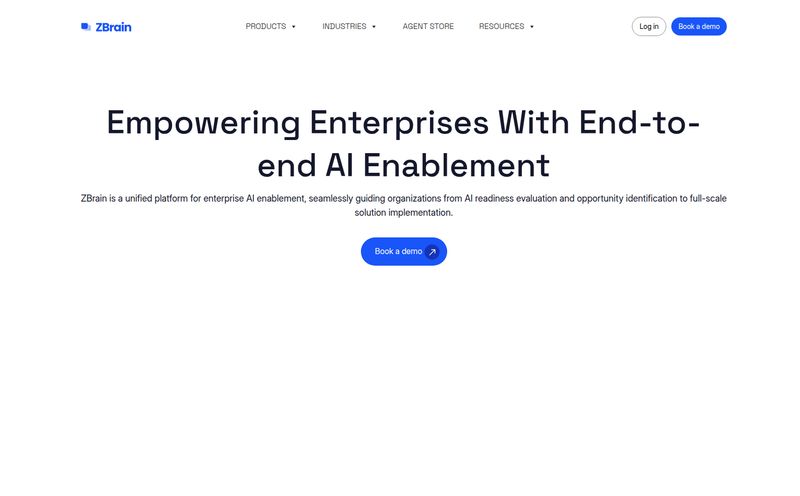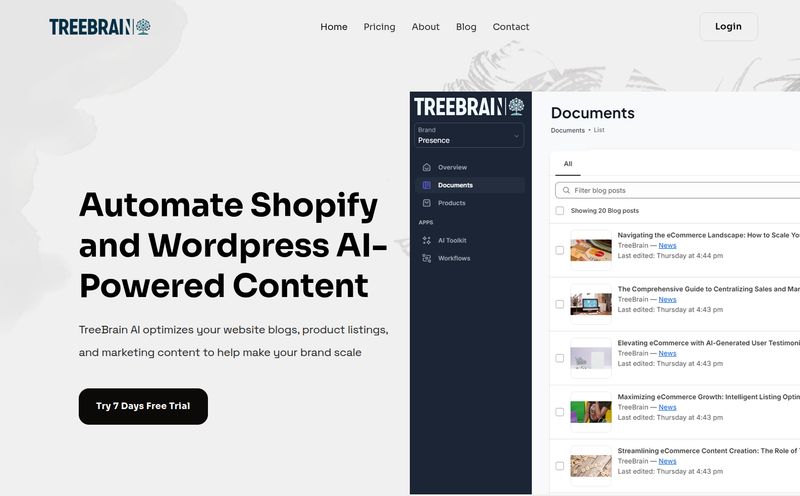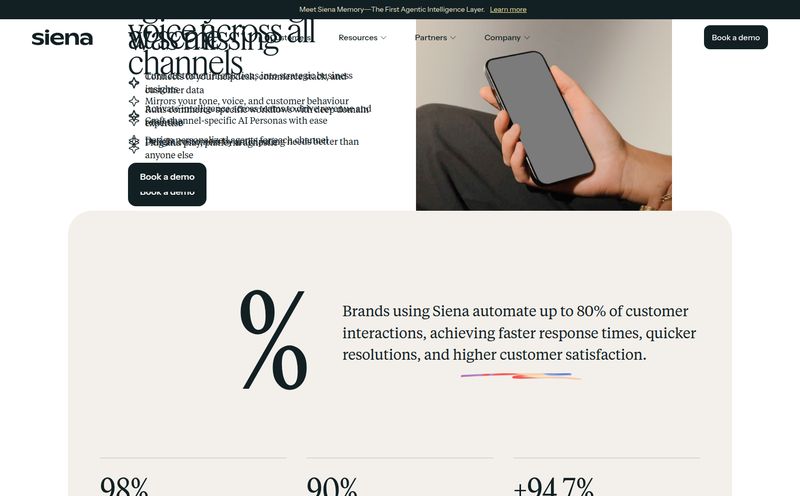The AI hype train is moving at a thousand miles an hour, and every single day there’s a new tool that promises to change your life. As someone who’s been in the SEO and traffic game for years, I’ve seen these waves come and go. But the current AI boom… this one feels different. It feels more personal.
We've all played with ChatGPT. It’s brilliant. It can write a poem, debug some code, or plan a trip to Tuscany. But ask it about the specifics of your latest marketing report or the internal documentation for your small business, and it just gives you that polite, blank stare. It doesn't know your world.
That’s the gap everyone is trying to fill right now. The race is on to create a truly personal AI. And that’s where tools like Whismer come swaggering in. The pitch is simple and seductive: build a custom AI chatbot using your own data. No code required. Naturally, my curiosity got the best of me. Is this another flash-in-the-pan, or is it a genuinely useful tool for folks like us? I had to find out.
What on Earth is Whismer Anyway?
So, what is this thing? Think of Whismer as a personal trainer for an AI model. You provide the training materials—your documents, website links, random notes scribbled at 2 AM—and it creates a specialized AI that knows your subject inside and out. It’s like giving ChatGPT its own private, curated library to study from. A library filled exclusively with your stuff.
Instead of drawing from the vast, chaotic ocean of the public internet, your Whismer AI draws from the clean, filtered pool of your own knowledge. You can upload PDFs, Word docs, CSVs, or just plain text files. You can point it to specific websites. You build a knowledge base, and then you can chat with it. Simple. On paper, at least.

Visit Whismer
This whole process is part of a technology called Retrieval-Augmented Generation (RAG), for the nerds in the back. But you dont need to know that. All you need to know is that it lets you ground the AI in facts. Your facts. This is huge for businesses needing an internal expert system, researchers organizing papers, or even students creating a study bot from their lecture notes.
The Alluring Promise of No-Code AI
The term "no-code" gets thrown around a lot. It’s the great democratizer of our time, turning complex technical feats into something you can assemble with a drag-and-drop interface. I've always been a bit of a skeptic. Often, "no-code" just means "a different, more frustrating kind of code."
But I have to admit, Whismer keeps its promise here. Setting up a new AI project is shockingly straightforward. You create a project, give it a name, and start feeding it information. There's no complex configuration or API wrangling. You just upload your files and add your links. It feels less like programming and more like organizing a Dropbox folder. A very, very smart Dropbox folder.
This ease of use is, in my opinion, its biggest strength. It lowers the barrier to entry so much that anyone who can use a computer can now build their own specialized AI. That's a powerful idea.
Putting Whismer's Features Through Their Paces
Alright, let's get into the nitty-gritty. How does it actually perform? I threw a few different scenarios at it to see where it shined and where it stumbled.
Creating Your Custom Knowledge Base
The first step is building the brain. I decided to create a little SEO assistant for a fictional client. I uploaded a couple of old SEO audit PDFs, a .CSV file of keywords, a link to the client’s blog, and a few raw text notes about content strategy. The platform supports .PDF, .DOC, .CSV, and .TXT, which covers most of the bases for standard business documents. The upload process was smooth. It ingested the data without any fuss, and within a few minutes, my knowledge base was ready.
Getting Answers and The Quality of Interaction
This is the moment of truth. I started asking questions. "Summarize the key findings from the technical SEO audit." It spat back a surprisingly coherent summary. "What are the top 5 keywords from the CSV file with a search volume over 1,000?" Bam, it pulled them out. "Based on the blog, what topics do they write about most frequently?" It gave me a thematic breakdown. It wasn’t perfect—some nuanced queries required a bit of rephrasing—but it was far more useful than I anticipated. It felt like talking to a junior assistant who had actually read all the briefing documents.
Sharing and Team Collaboration
This is where I see massive potential for small businesses. You can create a project and share it with your team. Imagine an internal knowledge base for your company's policies. Instead of searching through a clunky intranet, a new hire could just ask, "What's our policy on vacation days?" Or a customer support team could have a bot trained on every help article and technical manual you've ever written. It turns static documentation into a dynamic, conversational resource. Very cool.
Let's Talk About the Price Tag
Okay, great tech is one thing, but what’s it going to cost? Whismer has a tiered pricing structure that seems designed to scale with you. I’ve broken it down here because this is often the deciding factor.
| Plan | Price/Month | Key Features |
|---|---|---|
| Free | $0 | 5 AI Projects, 10 Queries/day, 100MB Storage |
| Standard | $19 | Unlimited Projects, 2,000 Queries/month, 20GB Storage |
| Pro | $39 | Unlimited Projects, 6,000 Queries/month, 60GB Storage |
| Enterprise | $69 | Unlimited Projects & Queries, 120GB Storage, Embed without logo |
My take? The Free plan is a perfect sandbox. It lets you kick the tires and see if it works for your use case, but you will hit that 10-query-per-day limit fast. The Standard plan at $19/month feels like the sweet spot for solo operators, freelancers, or very small teams. 2,000 queries a month is pretty generous. The Pro and Enterprise plans are for when you're getting serious, likely using this for customer-facing applications or heavy internal team use. The big prize on the Enterprise plan is removing the "Powered by Whismer" logo when you embed the chatbot on your site.
Now, for a bit of a weird quirk. According to their terms, you can't downgrade from a higher-tier plan. That's... odd. I've been in the SaaS world a long time, and that's not a policy you see every day. It feels a bit like a Venus flytrap. Once you're in a higher plan, you're in. It's a bit of a head-scratcher and something to be very aware of before you decide to upgrade.
The Good, The Bad, and The AI
So, after all that, what's the verdict? No tool is perfect. Whismer has a lot going for it, but there are a few thorns among the roses. The biggest advantage is its sheer simplicity. The ability to spin up a custom-trained AI in minutes without writing a single line of code is genuinely impressive and opens up a ton of possibilities.
On the flip side, the limitations are real. The query and storage caps on the lower tiers are understandable, but that no-downgrade policy is a major point of friction for me. It penalizes you for trying a higher tier and realizing it's more than you need. And, of course, having to pay top dollar just to remove their branding from an embedded chatbot is a classic SaaS play, but still a bit of a bummer.
Who is Whismer Actually For?
I think this tool has a few ideal users:
- Small Business Owners: Perfect for creating an internal helpdesk or a simple customer support bot trained on your products.
- Content Creators & Researchers: An amazing way to organize mountains of research, articles, and sources into a single, queryable brain.
- Students: Imagine feeding all your lecture notes, textbooks, and research papers into an AI and then using it as a 24/7 study partner. Game-changer.
Who is it not for? Probably large corporations that need deep, custom integrations with existing enterprise systems. And, as mentioned, anyone who isn't comfortable with that no-downgrade policy should probably stick to the lower tiers.
Final Thoughts From a Fellow Marketer
Look, Whismer is a solid tool. It does exactly what it says on the tin, and it does it with a user-friendly interface that makes a complex technology accessible. From an SEO perspective, I'm already dreaming up ways to use it. Imagine feeding it all your keyword research, SERP analysis data, and content briefs for a dozen clients. You could create a central "agency brain" to streamline strategy and answer quick questions.
Is it going to replace a human expert? No. But it can make that expert faster, smarter, and more efficient. It’s a powerful assistant. Despite its quirks, Whismer is a compelling example of where AI is headed—not just as a general-purpose oracle, but as a personalized, specialized tool that knows your world as well as you do.
Frequently Asked Questions about Whismer
- What is Whismer in simple terms?
- It's a tool that lets you build your own private AI chatbot. You give it your files and links (like a knowledge base), and it uses that information to answer your questions accurately.
- Can I use my own OpenAI API key?
- The platform doesn't mention this, so it appears to be a fully managed service. You pay for the queries through their subscription plans, not your own API key, which simplifies the process for non-technical users.
- What kind of files can I upload to Whismer?
- You can upload several common formats, including .PDF, .DOC, .CSV, and .TXT files, making it versatile for most business and personal documents.
- Is Whismer free to use?
- Yes, there is a free plan available. It's a great way to test the service, but it has limitations, such as a cap of 10 queries per day and limited storage space.
- What happens if I go over my monthly query limit?
- Typically with services like this, your ability to ask questions will be paused until the next monthly cycle begins, or you'll be prompted to upgrade to a higher-tier plan.
- Why can't I downgrade my Whismer plan?
- This is an unusual policy. It could be due to a technical reason related to how resources are allocated, or it could be a business decision to encourage users to stay on higher-revenue plans. It's best to start with a lower plan and upgrade only when you are certain you need the extra features.



